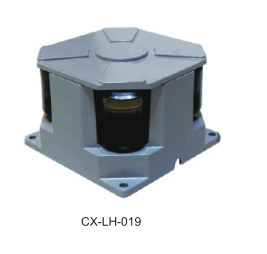With the deepening of urbanization in China, high-end communities, garden villas, and comprehensive facilities that are intelligently managed in large and medium-sized cities (hereinafter collectively referred to as "smart communities") need to be equipped with efficient and environmentally friendly intelligent lighting control systems. Remotely, intelligently and personalize the lighting equipment information acquisition and control methods. The lighting design of the modern intelligent community is not only the lighting design of the road and courtyard of the community, but also often includes some landscape lighting design. The main Road Lighting, branch lighting, and green landscape lighting of the community can be powered by separate circuits, so that individual lighting can be controlled according to different needs to save power.
1 Advantages of ZigBee protocol applied to intelligent community lighting
ZigBee technology is a short-range, low-complexity, low-power, low-speed, low-cost two-way wireless communication technology, mainly suitable for the field of automatic control and remote control, can be embedded in various devices, while supporting geolocation function . ZigBee technology's low data rate and small communication range make it suitable for carrying small data traffic services.
The IEEE802. 15.4 protocol defines two physical layer standards, namely 2.4 GHz physical layer and 868 / 915MHz physical layer. 2. The 4GHz band is a globally unified ISM band that does not need to be applied, which is helpful for the promotion of ZigBee equipment and the reduction of production costs. In order to avoid interference, in addition to the 2. 4GISM band, Europe also uses the 868MHz band, and the United States uses the 915MHz band as ZigBee ’s Working frequency. These frequency bands are relatively close, and slight changes to the signal synthesizer program can use similar hardware, thereby reducing production costs.
Because the propagation loss of the wireless signal in these two frequency bands is small, the requirement on the sensitivity of the receiver can be reduced, and a longer effective communication distance can be obtained, so that a larger area can be covered with less equipment. The ZigBee network contains 3 types of nodes, namely coordinator, router and terminal equipment, and supports 3 network topologies of star, tree and mesh.
It can be seen from the characteristics of the ZigBee protocol that the ZigBee wireless sensor network used in the street lighting control system of the intelligent community has the following characteristics: short distance, small range transmission, and cost advantage; the frequency range has strong anti-interference in the community, and can Use the regional characteristics of the cell to select a suitable network topology, and the network is simple and reliable; after a reasonable layout, no communication blind zone can be achieved in a cell, and its geographical positioning function is used to facilitate the LED street lamps in the cell distribution area management.
2 System design
As shown in Figure 1, the entire system is composed of community Street Lamp monitoring and management system, wireless sensor network, Led Street Lamp branch controller, LED street lamp and drive circuit, ZigBee terminal branch control node and ZigBee terminal environmental parameter detection node. The entire system is designed to operate automatically according to the environmental parameters of the community (such as brightness, temperature, and humidity) without manual intervention, and it can detect the working status of each street lamp in the community in time and track and maintain it in time. The intelligent community information management center (PC monitoring station) is responsible for monitoring the operation of the street lights in the entire community, and can manually control the switch and brightness of each street light according to the console command. It uses the RS232 serial port to communicate with the ZigBee network; the wireless sensor network is responsible for transmission monitoring The command of the station and collect the status information of the ZigBee terminal node; the terminal node is responsible for the control and drive of the LED street lamp; the ZigBee terminal branch voltage and current detection circuit is used to detect the voltage and current status of the entire branch; the ZigBee terminal environmental parameter detection circuit is used to detect The environmental parameters of the entire community, including light intensity, temperature, and humidity, are used as the basis for ZigBee terminal control.

Figure 1 System composition block diagram
2.1 ZigBee networking design
2. 1. 1 ZigBee network development tool selection
ZigBee wireless sensor network uses Chengdu Wireless Dragon C51RF-3 system. Its processor uses TI's CC2430, a single chip integrates ZigBee radio frequency (RF) circuit and microcontroller, it uses an 8-bit MCU (8051), with 128kB programmable flash memory and 8kB RAM, also contains analog- Digital converter (ADC), timer (TImer) and AES128 co-processor [4]. The C51RF-3 system supports the ZigBee2006 protocol and is a cost-effective, efficient, convenient, fast, and reusable development tool suite that fully meets the wireless network technology design and development of the IEEE 802.15.4 standard and ZigBee technical standards. In terms of networking, the C51RF-3 system can realize the formation of string and star networks. The default parameters in the ZigBee2006 protocol are: the maximum routing depth MAX_DEPTH = 5, the maximum number of child nodes MAX_CHILDREN = 20, the maximum number of routing child nodes MAX_ROUTERS = 6, these three important network parameters determine the size of the wireless sensor network by default [3]. In the C51RF-3 system, the barrier-free wireless transmission distance of ZigBee devices can reach 100m; in the case of obstacles, the reliable transmission distance exceeds 30m, so the network can be easily deployed in the community. For some large communities, the transmission distance can be extended by modifying the maximum routing depth of the network and the maximum number of routing nodes. A star network is used in the design of this system, as shown in Figure 2.

Figure 2 Network design of the system
ZigBee wireless network development platform C51RF-3-PK software development platform IAR Embedded Workbench (abbreviated as EW) provides the same intuitive user interface for different microprocessors [5]. Three types of devices are defined in the Demo Code of this development system, which are the coordinator (COORDINATOR), router (ROUTER) and end node (ENDDEVICE). When developing their own applications, users can easily develop various devices that form a ZigBee wireless sensor network by changing the compilation configuration items, and embed an operating system OS in their ZigBee protocol stack, with task message communication and timeout feedback mechanism , Users can easily expand their applications.
The node addressing principle of the ZigBee network: When the ZigBee network is initialized, the coordinator assigns a 16-bit short address to each node according to the MAC address of each terminal in the network. This address is unique in the network and is built in the coordinator. A two-dimensional table including the MAC address and 16-bit short address of each node. According to this table, the cell information management platform can address each node, which can easily realize the operation of a single lamp or broadcast information. Realize control of all nodes in the ZigBee network. The forwarding and routing of information is done automatically by the network without application intervention.

Figure 3 Intelligent community network management flow chart
2. 1. 2 ZigBee network management process design
After all the ZigBee network equipment is powered on, the ZigBee network is automatically networked. After a period of time (settable in the system), the network coordinator transmits the entire network status information to the host street lamp monitoring system through the RS232 serial port to form The monitoring platform displays the graphic display information of street lamps based on regions on it. The LED street lamp management scheme of the entire smart community uses a four-level control strategy, as shown in Figure 3, where the community administrator needs to interfere with the operation of the LED street lamp lighting system only in emergency or special circumstances after configuring the system, and It can monitor the operation of the entire lighting system; the street lamp monitoring system of the smart community adopts a date-based control strategy, and different lighting schemes can be used on different days (such as holidays); The lighting of the entire network, especially in some special weather, such as cloudy days and thunderstorms, can automatically turn on the lighting system; the final lighting of LED street lights is controlled and implemented through the ZigBee terminal. Under normal circumstances, time-based Control strategy to control the switching of LED street lights.
2. 2 street lamp node control design
There are two ways to control the street lamp node. The first is based on a single lamp control method, the system can independently control the switch, power, and light color of each lamp (using R, G, and B three-color LEDs, based on the principle of three primary colors), so that it can be conveniently based on the environment Parameters, such as light intensity, humidity, temperature, and time, set specific lighting control strategies, such as displaying different colors and brightness on holidays; the second is a branch-based control method, which controls the branch power To achieve, according to the branch voltage, the branch voltage and current value measured by the current sensor to determine whether the branch's working power and working state are normal.
The LED street lamp driver chip adopts PT4115, and its maximum power is 36W, and multiple PT4115 chip combinations can be used in the occasions with higher power requirements. PT4115 is a continuous inductor current conduction mode buck constant current source, its input voltage range is 8 ~ 30V, the output current is adjustable, up to 1. 2A, according to different input voltage and external devices, PT4115 can drive LEDs up to tens of watts; PT4115 has a built-in power switch, which uses high-end current sampling to set the average LED current, and can accept analog dimming and a wide range of PWM dimming through the DIM pin. The effective dimming range of the DC voltage on the DIM pin It is 0.5 to 2. 5V. When the DC voltage is higher than 2.5V, the output LED current remains constant and is set by (0.1 / RS). The system uses the CC2430 I / O port to generate PWM waveform to control The brightness of the street lamp, when the voltage of the DIM pin is lower than 0.3V, the power switch is turned off, and the PT4115 enters a standby state with an extremely low operating current; its conversion efficiency is as high as 97%, and the output current accuracy is ± 5%; the chip has overtemperature , Overvoltage, overcurrent, LED open circuit protection and other functions; using SOT89-5 package, which is conducive to the rapid heat dissipation of the driving chip die; its application circuit is simple, only 4 components around, and the application cost is low. As shown in Figure 4.

Figure 4 Control circuit of the terminal node
3 Summary
Through the research on the LED street lamp control system of the intelligent community based on ZigBee technology, the application advantages of ZigBee technology and the application characteristics of the LED street lamp in the intelligent community are discussed, and the implementation plan of the system is given. Residential lighting solutions.
LED point light source is a new kind of energy conservation and environmental protection decorative light, using LED cold light source, the built-in microcomputer chip, can be arbitrary programming control, multiple synchronous change, monochromatic changes can also be realized synchronous colorful gradient, jump, scanning, running water light color change effect and multiple LED point light source form a lattice screen.All kinds of pictures, text and animation effects can be changed. It is a supplement of linear light source and flood lighting, which can meet the design requirements of the point line surface.


Product size

Led Point Lamp,Blue Point Led Lamp,Led Point Ovale,Led Blue Point
Jiangsu chengxu Electric Group Co., Ltd , https://www.satislighting.com